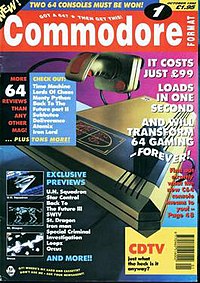Commodore Format

Commodore Format #1, October 1990
|
|
| Former editors |
Steve Jarratt Collin Campbell Trenton Webb Andy Hutchinson Dave Golder Tim Norris & Karen Levell Rebecca Lack Karen Levell Simon Forrester |
|---|---|
| Categories | Computer magazine |
| Frequency | Monthly |
| Circulation | 50,135 Jan-Jun '91 55,178 Jul-Dec '91 60,045 Jan-Jun '92 44,442 Jul-Dec '92 41,626 Jan-Jun '93 25,063 Jul-Dec '93 |
| First issue | October 1990 |
| Final issue — Number |
October 1995 Issue 61 |
| Company | Future plc |
| Country | United Kingdom |
| Language | English |
| ISSN | 0960-5169 |
Commodore Format was a British magazine for users of the Commodore 64 home computer. It was published on the third Thursday of every month. All 61 issues were produced by Future plc. These came towards the end of the machine's commercial life - from October 1990 until October 1995.
The launch editorial staff was dominated by journalists who had worked on Zzap!64, including editor Steve Jarratt. Sean Masterson was Steve's deputy. Contributions came from Gordon Houghton and Kati Hamza. There was one fresh face - staff writer, Andy Dyer.
The first issue previewed the new cartridge-based C64 GS (Games System). The magazine had 98 pages and came with a games tape known as the "Power Pack". Issue one's tape included a playable preview of upcoming arcade conversion Iron Man, and the full version of Tau Ceti. It retailed for £1.95.
The magazine's content was varied, but heavily biased towards gaming. Each issue usually kicked off with a news section called "Network 64" - a round-up of the previous month's C64 stories. The section was renamed "Snippets" in later issues. After initially appearing at the very back of the magazine, the "Early Warning!" preview section usually followed. It featured a full-page submarine style "scanner" showing how near to release new games were. The scanner featured six rings; if a game was placed on the outer ring, it was six months from release. Graphics and charts like this made the magazine's information easy to digest and were common. The letters page was next. It featured "The Mighty Brain", a cartoon character noted for its arrogance in answering the readers' questions. "Andy Dyer's Gamebusters" (later by Andy Roberts) provided tips and cheats on the latest software releases, and Paul Lyons' "Inside Info" column answered technical questions. This section was latterly written by Jason Finch and renamed "Techie Tips". And every month there was a large review section of the latest games - those scoring over 90% received the "It's A Corker" accolade, and an "Uppers and Downers" box at the end of each review made it easy for readers to see just how good a game was at a glance.
One of Commodore Format′s most famous sections was "Roger Frames Buys Budjit Games". The budget game round-up was accompanied by a story told in three or four cartoons. Drawn by artist Mike Roberts, they were often inspired by the games Roger was playing. Famously, Roger appeared on the cover of the Codemasters game "Tilt". There was also a Roger Frames "UGH! GIRLS" T-shirt, and readers could send in photos of themselves or their friends if they thought they looked a bit like Roger. As Commodore 64 software became increasingly scarce, Roger's column was removed by editor Trenton Webb following a redesign in 1993. But his presence remained in the magazine in one form or another until the very final issue - whose cover he graced.
...
Wikipedia
